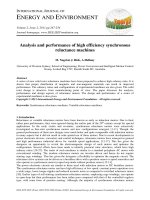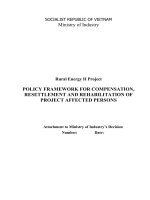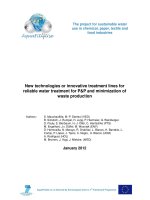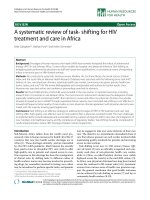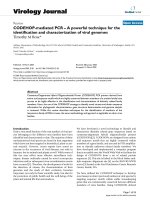Orientations for efficient treatment and processing of high CO2 content natural gas resources in Vietnam
Bạn đang xem bản rút gọn của tài liệu. Xem và tải ngay bản đầy đủ của tài liệu tại đây (406.95 KB, 7 trang )
PETROLEUM PROCESSING
PETROVIETNAM JOURNAL
Volume 10/2019, p. 14 - 20
ISSN-0866-854X
Orientations for efficient treatment and processing of high CO2
content natural gas resources in Vietnam
Nguyen Huu Luong
Vietnam Petroleum Institute
Email:
Summary
CO2-rich natural gas sources are popular in Vietnam, with their CO2 contents in the range of 10 - 60 mol%. Based on various CO2
contents of natural gas sources, a certain number of technologies are recommended for their wise uses. If the gas contains less than 10
mol% of CO2, it can be used where urea production. In the case where its CO2 content is up to 25 mol%, methanol and dimethyl ether
(DME) production could be considered. Gas with CO2 content of up to 50 mol% could be a good feedstock for carbon nanotube (CNT)
production. On the other hand, if gas contains more than 50 mol% of CO2, CO2 removal should be an option, and separated CO2 could be
used as feedstock for production of various products, including methanol, DME, and CNTs.
Key words: CNTs, CO2-rich natural gas, DME, methanol, urea.
1. Introduction to CO2-rich natural gas sources in
Vietnam
Vietnam is in the region of CO2-rich gas fields. It
currently holds 700 billion cubic metres of proved
natural gas reserves [1]. A number of gas fields have been
discovered with high reserves but their gas composition
contains a significant amount of CO2, ranging from 10 60 mol%. In 2011, the biggest gas field, Ca Voi Xanh, was
discovered with the reserves of more than 150 billion cubic
metres of natural gas [2]. However, Ca Voi Xanh gas has a
high contents of impurities, especially CO2. Table 1 shows
its hydrocarbon and non-hydrocarbon composition.
Besides Ca Voi Xanh, other gas fields and wells have
also been found with high contents of CO2, including
Block B, Ca Ngu Vi Dai, Ca Map Trang, and some wells in
Table 1. Composition of Ca Voi Xanh gas [2]
Component
N2
CO2
H2 S
C1
C2
C3
C4
Composition (mol%)
9.88
30.26
0.21
57.77
0.92
0.31
0.18
Date of receipt: 25/4/2019. Date of review and editing: 25 - 28/4/2019.
Date of approval: 11/11/2019.
14
PETROVIETNAM - JOURNAL VOL 10/2019
the Southern Song Hong basin. The presence of CO2 in
gas composition decreases its quality due to its low heat
value and related issues during its storage, transportation
and processing. In Vietnam, more than 80% of natural
gas is currently used for power production. It can be
seen that these CO2-rich gas sources are not ideal for
this usage because CO2 is a zero-heat-value component.
However, CO2 consists of carbon and oxygen elements
that are present in the composition of chemicals used in
industries and civil life. In fact, CO2 should be considered
a resource rather than a waste. Therefore, it is interesting
and important to determine suitable ways for efficient
use of these gases via technologies that can process both
hydrocarbons and CO2 into high-value products. In this
paper, suitable technologies for natural gas processing
in relation to its CO2 content are recommended. Their
maturity is also pointed out.
2. Natural gas with its CO2 content up to 10 mol% - A
feedstock for urea production
Urea (NH2CONH2) is of great nutrition to soil as a
nitrogen-rich fertiliser. Natural gas is one of the important
feedstocks to produce hydrogen that is used for ammonia
synthesis in urea production. The transformation of
natural gas with methane as a representative component
into urea is described by Equations 1 - 6.
CH4 + H2O ⇌ CO + 3H2
(1)
PETROVIETNAM
CH4 + 2H2O ⇌ CO2 + 4H2
(2)
3H2 + N2 ⇌ 2NH3
(4)
CO + H2O ⇌ CO2 + H2
(3)
(5)
2NH3 + CO2 ⇌ NH2COONH4
(6)
NH2COONH4 ⇌ NH2CONH2 + H2O
In fact, natural gas accounts for more than 95% of ammonia
production worldwide [3]. Ammonia and urea have been produced in
large quantities from natural gas since 1950s. Therefore, it is a mature and
widely implemented technology with minimal technology risk [3]. For
urea synthesis, CO2 is needed (in addition to ammonia) and commercial
processes are available for processing high-CO2-content gas feedstock,
such as Haldor Topsoe, Uhde, KBR. Based on a carbon balance for the
whole urea production, a natural gas containing 8 mol% of CO2 is a good
feedstock for urea production such as in the case of the Ca Mau Fertilizer
Plant, Vietnam.
3. Natural gas with its CO2 content of 10 - 25 mol% - A feedstock for
methanol and dimethyl ether (DME) production
If the natural gas contains 10 - 25 mol% of CO2, it is a preferable
feedstock for methanol and dimethyl ether (DME) production. CO2 is
needed for methanol synthesis as described by the following equation:
(7)
3CH4 + CO2 + 2H2O ⇌ 4CH3OH
Stoichiometrically, it can be seen that a mixture of CH4 and CO2 with
its molar ratio of 3 (i.e. gas contains 25 mol% of CO2) is the right feedstock
for methanol production. Methane reforming for methanol production is
a well developed and implemented technology. It is worthy to notify that
the presence of CO2 in the natural gas brings two impacts: (1) enhancement
of coke formation during the reforming; and (2) contribution to methanol
synthesis. In order to overcome reforming catalyst deactivation due to
Pilot test
Noble metal cat
P = 23.5 bar
TOS = 490h
10
9
8
Coke free zone
H/C [mol/mol]
/CH 4
H 2O
5
Graphite
carbon limit
4
3
2
CO
/
2
1
0
CH
4
0
0,5
Recently, DME has been promoted as
an alternative fuel for LPG and diesel. In
industry, DME can be produced via one of
the two routes: (1) one-step process using
a direct conversion of syngas into DME in
a single reactor; or (2) two-step process
using methanol synthesis and DME
synthesis in separate reactors [5]. DME
production processes are relatively well
established with a number of technology
licensors, including Haldor Topsoe, JFE
Ho., Korea Gas Co., Air Products, and NKK
for the one-step process, and Toyo, MGC,
Lurgi, Uhde for the two-step process.
It is interesting to develop a new
process that can transform CO2-rich
natural gas into methanol and DME in
the one-step process as described by the
following equations:
CH4 + CO2 ⇌ CH3OH + CO
(8)
2CH4 + 2CO2 ⇌ CH3OCH3 + CO + H2O (9)
7
6
fast coke formation, two solutions could
be considered: (1) increase in the ratio of
steam/C used; or (2) development of new
generation catalyst based on noble metal.
Haldor Topsoe has established a chart
showing the relationship between the
ratios of steam/C and CH4/CO2 with coke
formation during methane reforming
(Figure 1). In 2014, Haldor Topsoe
demonstrated a pilot plant to perform a
bi-reforming of CH4 - CO2 mixture using a
noble metal-based catalyst with a reduced
ratio of steam/C without significant coke
formation in Brazil [4].
1
1,5
O/C [mol/mol]
2
2,5
3
Carbon limit on typical industrial Ni cat
P = 25.5 bar, T = 400 - 1000 oC
Figure 1. Relationship between the ratios of steam/C and CH4/CO2 with coke formation (used with Haldor Topsoe’s
permission) [4].
Until now, this route has only been
performed in lab scale due to very low
methanol yield (<5%) [6]. Accordingly,
an equimolar mixture of CH4 and CO2
is converted into methanol under
non-thermal plasma condition (600
- 1000oC and atmospheric pressure)
without catalyst. It is expected that the
integration of an acidic catalyst into the
system will promote this conversion for
DME formation.
PETROVIETNAM - JOURNAL VOL 10/2019
15
PETROLEUM PROCESSING
4. Natural gas with its CO2 content of 25 - 50 mol% A feedstock for dry reforming and carbon nanotube
(CNT) production
For natural gas sources containing up to 50 mol%
of CO2 in their gas composition, carbon nanotube (CNT)
production could be an option. In fact, a natural gas with
its molar ratio of CH4 and CO2 of approximately 2 is a good
feedstock for CNT production via methane decomposition
pathway. CNT is applied in various areas, including
plastics, electronics, fuels, and batteries. CNT’s current sale
price varies in a wide range and can be well above USD
1,000/gram depending upon its quality and application.
This value is much higher than that of amorphous carbon.
The market for CNTs is predicted to be 20,000 tons/year
by 2022 [7].
Methane decomposition is described by the following
equation:
CH4 ⇌ C + 2H2
(10)
The presence of CO2 in the feedstock has been shown
to bring benefits to CNT formation. Accordingly, both CNT
yield and its quality are enhanced [8 - 10]. CO2 is assigned
to participate in a series of reactions, including methane
dry reforming, Boudouard, and reverse water-gas shift to
produce steam that has been well known as a good agent
to remove defects during CNT production [8]. As a result, a
natural gas containing approximately 33 mol% of CO2 can
be a good feedstock for CNT production as described by
the following reactions:
2CH4 + CO2 ⇌ 3C + 2H2 + 2H2O
2CH4 + CO2 ⇌ 2C + 3H2 + CO + H2O
(11)
(12)
For gas containing 50 mol% of CO2, that will be the
great to process it without CO2 removal. In this case,
a technology to convert both hydrocarbon and CO2
is needed. A process to satisfy this requirement is dry
reforming. Equation (13) shows how an equimolar mixture
of methane and CO2 can be transformed into a mixture
of CO and H2 known as syngas, which is an important
feedstock for petrochemical synthesis and H2 production.
CH4 + CO2 ⇌ 2CO + 2H2
(13)
Dry reforming is considered an environmentally
friendly syngas production route. It was estimated that
the production cost of methanol using dry reforming is
lower than using the traditional steam reforming [13]. This
process has been studied for a long time in the lab but
cannot be implemented in the industry due to its strong
16
PETROVIETNAM - JOURNAL VOL 10/2019
coke formation, leading to fast catalyst deactivation.
However, in 2015, it was reported that the Linde Group
officially opened a dry reforming pilot facility in Germany
[13]. The following reactions are responsible for coke
formation during methane dry reforming.
CH4 ⇌ C + 2H2
2CO ⇌ C + CO2
(14)
(15)
Recently, this process has drawn interests back again
for CNT production. Braga et al. reported the appearance
of CNTs in coke formed during methane dry reforming
[11]. It has been found that a high CO2 conversion and
high carbon yield can be achieved with a mixture of
CH4 and CO2 with its molar ratio of 2 as feedstock. In
comparison with methane decomposition, dry reforming
results in much lower CNT yield but its CNT owns higher
quality and is formed at a lower temperature [12]. In order
to bring this process into the industry, a number of issues
need to be solved, including: (1) enhancement of CNT
yield and catalyst life; and (2) development of a reactor
type that is more effective for CNT collection and catalyst
regeneration.
It is worth noting that CNT production via both
pathways also produces hydrogen that can be sold for
refineries, and hence, increases its economic efficiency.
Nowadays, CNT is commercially manufactured from
ethylene at not large capacities with high production cost
due to difficulties of CNT purification and its quality control.
CNT production from methane as feedstock has been
reported at lab scale but only a few papers mentioned the
impact of CO2 during CNT formation. Therefore, in order to
add more value to CO2-rich natural gas sources of Vietnam,
it is important to develop an efficient process to transform
both CO2 and hydrocarbons into CNTs.
5. CO2 - A feedstock for CNT, methanol and DME production
Natural gas contains more than 50 mol% of CO2 should
be considered for CO2 removal, then the treated gas can
be processed by traditional technologies. CO2 separated
from CO2-rich natural gas, along with other CO2-rich
sources such as flue gas from power and fertiliser plants,
can be feedstocks to produce dry ice and liquid CO2 for the
food industry. Besides, it can also be used for production
of a number of products, including methanol, methane,
dimethyl ether (DME), and carbon nanotubes (CNTs).
Figure 2 shows possible pathways for CO2 use, including
storage, direct use and conversion into chemicals.
PETROVIETNAM
Depleted Oil & Gas Fields
Deep Saline Formations
Aquifers
Mineral Storage
Re and Afforestation
Storage
Direct Use
Enhanced Oil Recovery
Supercritical Solvent
Geothermal Fluid
Beverages & Microcaps
Solvent
Working Fluid
Heat Transfer
CO2
Conversion
Solar Wind Geothermal
Tidal Hydro etc.
Chemical
Biological
Electrochemical
Photochemical
Water Hydrogen
Other chemicals
Feedstock
Biodegradable Pollymers
Urea, Isocyanates & Carbarnates
Carboxylane & Lactones
Inorganic & Organic Carbonates
Energy Vector
Renewable Fuels
Syngas, Methane etc.
Formic Acid, Methanol & DME
Figure 2. Possible pathways for CO2 use [13].
H2 is from electrolysis of H2O by using
renewable resources or atomic energy
Energy
Solar
Wind
Hydro
Geothermal
Atomic
CO2
Reduction
CH3OH
High density CO2 from plants,
etc. may be the first source
but, ultimately quiet low
density CO2 in the air
CH3OH
and
CH3OCH3
Synthetic
hydrocarbons
and their products
CARBON NEUTRAL CYCLE
CO2 + 2H2O
CO2
CH3OH + 3/2 O2
Fuel uses
Figure 3. A methanol economy was proposed by Olar et al. [14].
Methanol is an important feedstock for petrochemical
production or alternative fuel. Via a series of commercial
technologies, namely MTO (methanol-to-olefins), MTP
(methanol-to-propylene), MTA (methanol-to-aromatics),
and MTG (methanol-to-gasoline), methanol serves well
for both petrochemical and fuel industries. On the other
hand, methanol is also used directly as an alternative
fuel in some countries. In fact, a methanol economy was
proposed by Olar et al. [14]. Directions of this economy
are illustrated in Figure 3, thus, there is an interest in
transforming CO2 into methanol. A large number of
research groups are participating in this subject [15 - 18].
In 2013, the Vietnam Petroleum Institute (VPI) carried
out a study to hydrogenate CO2 into methanol using
a membrane reactor and a multifunctional catalyst.
It has been shown that both membrane reactor and
multifunctional catalyst bring positive impacts on the CO2
conversion and methanol yield [19 - 20]. However, this
PETROVIETNAM - JOURNAL VOL 10/2019
17
PETROLEUM PROCESSING
CO2, H2
H2
Producced via water splitting
using renewable energy
H2O → H2 + ½ O2
CO2
H2O
Conversion unit
2CO2 + 6H2 → DME + 3H2O
Separation
unit
DME
Emitted from power plants,
vehicles, ctc.
Figure 4. A “zero-CO2 emission” concept from DME [22].
process is not economic due to the high cost of hydrogen
consumption. In 2011, a semi-commercial methanol plant
with the capacity of 4,500 tons/year was commissioned
in Iceland, using CO2 and H2 as feedstock [21]. Cheap H2
is supplied by water splitting using available geothermal
energy in Iceland. It has been reported that the CO2to-methanol process will become more realistic when
methanol price roughly doubles or hydrogen price
decreases almost 2.5 times [13].
Methanol can be dehydrated into dimethyl ether (DME)
using a number of commercial processes by licensors such
as Haldor Topsoe, Air Products, Lurgi, and Uhde. On the
one hand, it is interesting to combine methanol synthesis
and methanol dehydration into one step to reduce DME
production cost. An integration of acid sites into methanol
synthesis could be a solution. Accordingly, along with the
usage of renewable energy, this will be a green process
and an effective way to store renewable energy as DME
[22]. Figure 4 shows a “zero-CO2 emission” concept from
DME. In order to bring this concept into the industry, the
following issues need to be solved, including the supply
of cheap hydrogen, water-resistant catalyst, and efficient
water separation.
18
PETROVIETNAM - JOURNAL VOL 10/2019
On the other hand, CO2 can also be used to synthesise
high-value products, such as carbon nanotubes (CNTs).
This is a highly potential direction to add more value to CO2.
There is no evidence that CNTs can be synthesised from
CO2 until the report by Motiei et al. in 2001 [23]. CO2 can
be transformed into CNTs using the following methods:
(1) supercritical CO2; (2) reduction of CO2 over oxygendeficient ferrite catalysts (ODF); (3) reduction of CO2 over
supported and unsupported transition metal catalysts;
and (4) CO2 electrolysis using molten salts [24 - 25]. The
electrolysis method seems to be the most efficient route
for CNT production from CO2. In 2017, the team of George
Washington University, US, developed a process named
C2CNT that can electrolyse CO2 into CNTs and O2 [25].
C2CNT technology directly removes, transforms and stores
CO2 in various concentrations: 5% CO2 (removed from the
air without preconcentration), 12.5% CO2 (removal of coal
power plant CO2 emissions), 33% CO2 (complete removal
of CO2 from cement production plants), or 100% [26]. It is
planned to construct a demonstration unit of C2CNT with
a capacity of 5 tons/day of CO2 at a power plant in Alberta,
Canada [26].
PETROVIETNAM
6. Conclusion
A number of CO2-rich natural gas sources have been
discovered in Vietnam, with their CO2 contents in the
range of 10 - 60 mol%. Therefore, processes to efficiently
convert both hydrocarbons and CO2 are required. Based
on various CO2 contents of natural gas sources, a number
of technologies are recommended for their wise uses. If
the gas contains less than 10 mol% of CO2, it can be used
for urea production. In the case where its CO2 content is
up to 25 mol%, methanol and DME production could be
considered. Gas with its CO2 content of up to 50 mol%
could be a good feedstock for CNT production. On the
other hand, if gas contains more than 50 mol% of CO2, CO2
removal should be an option, and separated CO2 could
be used as feedstock for production of various products,
including methanol, DME, and CNTs. While the maturity
of technologies has been investigated, further technoeconomic and environmental assessments should be
performed for each case.
References
1. Indexmundi. Vietnam natural gas - proved reserves.
www.indexmundi.com.
2. Nguyen Huu Luong, Nguyen Hoang Viet, Nguyen
Van Dung. Approaches to enhance the value of Ca Voi
Xanh gas via its transformation into nanocarbon materials.
Petrovietnam Journal. 2018; 10: p. 63 - 68.
nanotubes from CH4 over Ni catalysts. Carbon. 2012; 50:
p. 372 - 384.
9. A.V.Melezhyk,
A.V.Rukhov,
E.N.Tugolukov,
A.G.Tkachev. Some aspects of carbon nanotubes technology.
Nanosystem: Physics, Chemistry, Mathematics. 2013; 4(2):
p. 247 - 259.
10. Chuanwei Zhuo, Henning Richter, Yiannis
Levendis. Carbon nanotube production from Ethylene
in CO2/N2 environments. Journal of Energy Resources
Technology. 2018; 140.
11. Tiago P.Braga, Regina C.R.Santos, Barbara
M.C.Sales, Bruno R.da Silva, Antônio N.Pinheiro, Edson
R.Leite, Antoninho Valentini. CO2 mitigation by carbon
nanotube formation during dry reforming of methane
analyzed by factorial design combined with response surface
methodology. Chinese Journal of Catalysis. 2014; 35(4),
p. 514 - 523.
12. Zirui Jia, Kaichang Kou, Ming Qin, Hongjing
Wu, Fabrizio Puleo, Leonarda Liotta. Controllable and
large-scale synthesis of carbon nanostructures: A review on
bamboo-like nanotubes. Catalyst. 2017; 7: p. 256 - 276.
13. Sean M.Jarvis, Sheila Samsatli. Technologies and
infrastructures underpinning future CO2 value chains: A
comprehensive review and comparative analysis. Renewable
and Sustainable Energy Reviews. 2018; 85: p. 46 - 68.
www.
14. George A.Olah, Alain Goeppert, G.K.Surya
Prakash. Beyond oil and gas: The Methanol economy. 2018.
4. Haldor Topsoe. Handout of Haldor Topsoe’s
workshop in Ho Chi Minh City, Vietnam. 22 May 2014.
15. M.Aresta, A.Dibenedetto. Utilisation of CO2 as a
chemical feedstock: opportunities and challenges. Dalton
Trans. 2007.
3. Petrowiki.
petrowiki.org.
Gas as fertilizer feedstock.
5. Marcello De Falco. Dimethyl ether (DME) production.
www.oil-gasportal.com.
6. John E.Stauffer. Methanol production from methane
and carbon dioxide. US patent US10040737B2, 2018.
7. R.Dagle, V.Dagle, M.Bearden, J.Holladay, T.Krause,
S.Ahmed. R&D opportunities for development of natural gas
conversion technologies for co-production of hydrogen and
value-added solid carbon products. Argonne National Lab
Report. 2017.
8. Steven Corthals, Jasper Van Noyen, Jan Geboers,
Tom Vosch, Duoduo Liang, Xiaoxing Ke, Johan Hofkens,
Gustaaf Van Tendeloo, Pierre Jacobs, Bert Sels. The
beneficial effect of CO2 in the low temperature synthesis of
high quality carbon nanofibers and thin multiwalled carbon
16. M.Peters, B.Köhler, W.Kuckshinrichs, W.Leitner,
P.Markewitz, T.Müller. Design and simulation of a
methanol production plant from CO2 hydrogenation.
ChemSusChem. 2011; 4: p. 1216 - 1240.
17. E.Van-Dal, C.Bouallou. Design and simulation
of a methanol production plant from CO2 hydrogenation.
Journal of Cleaner Prodution. 2013; 57: p. 38 - 45.
18. Mar Pérez-Fortes, Jan C.Schöneberger, Aikaterini
Boulamanti, Evangelos Tzimas. Methanol synthesis using
captured CO2 as raw material: Techno-economic and
environmental assessment. Applied Energy. 2016; 161:
p. 718 - 732.
19. Tran Van Tri, Le Phuc Nguyen, Nguyen Hoai Thu,
Dang Thanh Tung, Ngo Thuy Phuong, Nguyen Anh Duc.
PETROVIETNAM - JOURNAL VOL 10/2019
19
PETROLEUM PROCESSING
Application of NaA membrane reactor for methanol synthesis
in CO2 hydrogenation at low pressure. International Journal
of Chemical Reactor Engineering. 2017.
fullerenes from supercritical CO2 by a chemical reaction.
Journal of the American Chemical Society. 2001; 123(35):
p. 8624 - 8625.
20. Le Phuc Nguyen, Tran Van Tri, Ngo Thuy Phuong,
Nguyen Huu Luong, Trinh Thanh Thuat. Correlation
between the porosity of γ-Al2O3 and the performance of CuOZnO-Al2O3 catalysts for CO2 hydrogenation into methanol.
Reaction Kinetics, Mechanisms and Catalysis. 2017.
24. Geoffrey S.Simate, Sunny E.Iyuke, Sehliselo
Ndlovu, Clarence S.Yah, Lubinda F.Walubita. The
production of carbon nanotubes from carbon dioxide:
challenges and opportunities. Journal of Natural Gas
Chemistry. 2010; 19: p. 453 - 460.
21. M.Bertau, H.Offermanns, L.Plass, F.Schmidt, H.-J.
Wernicke. Methanol: The basic chemical and energy
feedstock of the future. Asinger’s Vision Today. 2014.
25. Marcus Johnson, Jiawen Ren, Matthew Lefler, Gad
Licht, Juan Vicini, Xinye Liu, Stuart Licht. Carbon nanotube
wools made directly from CO2 by molten electrolysis:
Value driven pathways to carbon dioxide greenhouse gas
mitigation. Materials Today Energy. 2017; 5: p. 230 - 236.
22. Enrico Catizzone, Giuseppe Bonura, Massimo
Migliori, Francesco Frusteri, Girolamo Giordano. CO2
recycling to dimethyl ether: State-of-the-art and perspectives.
Molecules. 2017.
23. M.Motiei,
Y.RHacohen,
J.Calderon-Moreno,
A.Gedanken. Preparing carbon nanotubes and nested
20
PETROVIETNAM - JOURNAL VOL 10/2019
26. Stuart Licht. Carbon dioxide to carbon nanotube
scale-up. ww.arxiv.org.
